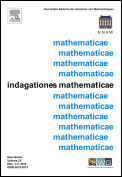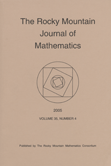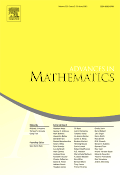
Frontiers of Mathematics
Scope & Guideline
Fostering Collaboration Across Mathematical Disciplines
Introduction
Aims and Scopes
- Theoretical Mathematics:
Focuses on pure mathematics, including areas such as algebra, geometry, topology, and analysis. The journal publishes foundational research that contributes to the understanding of mathematical structures and theories. - Applied Mathematics:
Covers the application of mathematical methods to solve real-world problems across various domains such as physics, engineering, and finance. This includes statistical methods, numerical analysis, and mathematical modeling. - Interdisciplinary Research:
Encourages research that intersects with other scientific fields, showcasing how mathematical techniques can be applied to solve complex problems in biology, computer science, and social sciences. - Mathematical Physics:
Includes research that bridges mathematics and physics, particularly in areas such as quantum mechanics, relativity, and dynamical systems, emphasizing the mathematical foundations of physical theories. - Dynamical Systems and Differential Equations:
Explores the behavior of complex systems over time, focusing on both deterministic and stochastic processes, as well as their mathematical representations. - Computational Mathematics:
Investigates numerical methods and algorithms for solving mathematical problems, with a growing emphasis on computational techniques and simulations.
Trending and Emerging
- Nonlinear Partial Differential Equations:
There has been a noticeable increase in research focusing on nonlinear PDEs, reflecting their importance in modeling complex phenomena in physics and engineering, as well as their mathematical intricacies. - Algebraic Structures and Generalizations:
The exploration of advanced algebraic structures, such as hom-algebras and their applications, is becoming more prevalent, indicating a growing interest in abstract algebra and its implications in various mathematical domains. - Stochastic Processes and Applications:
An upswing in papers addressing stochastic processes showcases their relevance in modeling uncertainty and randomness in various fields, particularly in finance, biology, and statistical mechanics. - Geometric Analysis and Topology:
Research at the intersection of geometry and analysis is on the rise, with an emphasis on geometric properties of differential equations and their applications in modern mathematical and physical theories. - Machine Learning and Mathematical Foundations:
The integration of machine learning techniques with mathematical theory is emerging as a significant trend, emphasizing the need for rigorous mathematical frameworks to support advancements in artificial intelligence and data science.
Declining or Waning
- Classical Geometry:
Research in classical geometric concepts and constructions appears to be less frequent, possibly overshadowed by more abstract or applied mathematical inquiries. This trend reflects a broader movement towards higher-dimensional and algebraic forms of geometry. - Elementary Number Theory:
Although foundational, publications specifically focused on elementary number theory have diminished, as researchers increasingly integrate number-theoretic concepts into broader algebraic or analytical frameworks. - Statistical Mechanics:
The area of statistical mechanics, while still relevant, has seen a decline in standalone papers, possibly due to the rise of more interdisciplinary approaches that incorporate statistical methods into complex systems analysis. - Discrete Mathematics:
Topics in discrete mathematics, including graph theory and combinatorics, are being published less frequently, with researchers favoring continuous mathematics and its applications. - Historical Studies in Mathematics:
Papers exploring the history of mathematics or its philosophical implications have become less common, indicating a possible shift towards more contemporary and applied mathematical discussions.
Similar Journals

TWMS Journal of Pure and Applied Mathematics
Advancing Mathematical Frontiers with IntegrityWelcome to the TWMS Journal of Pure and Applied Mathematics, a distinguished publication dedicated to advancing the field of mathematics through rigorous research and innovative applications. Published by the esteemed Institute of Applied Mathematics, this journal provides a platform for scholars and practitioners alike to share their findings and insights in both pure and applied mathematical disciplines. With a commitment to quality and integrity, the journal seeks to enhance the visibility and impact of mathematical research, reflected in its scholarly output. Although currently not an Open Access journal, the TWMS Journal aims to feature high-impact articles that contribute to both theoretical understanding and practical implementation. The journal’s address is located at Baku State University, ensuring its roots in a vibrant academic environment in Azerbaijan. As an essential resource in the mathematics community, the TWMS Journal of Pure and Applied Mathematics invites contributions that push the boundaries of knowledge and foster dialogue among researchers, professionals, and students.

INDIAN JOURNAL OF PURE & APPLIED MATHEMATICS
Pioneering Insights in Pure and Applied MathematicsINDIAN JOURNAL OF PURE & APPLIED MATHEMATICS, published by the INDIAN NATIONAL SCIENCE ACADEMY, stands as a vital resource in the realm of pure and applied mathematics since its inception in 1996. With ISSN 0019-5588 and E-ISSN 0975-7465, this journal aims to disseminate original research that advances the understanding and application of mathematical principles. Operating out of New Delhi, India, it serves a diverse readership comprising researchers, scholars, and practitioners in the mathematical sciences. Recognized within the Q3 category in both Applied Mathematics and Miscellaneous Mathematics as per the 2023 category quartiles, the journal emphasizes rigorous peer-reviewed articles that contribute to its impact in academia, reflected in its Scopus rankings. Although it does not currently operate as an open-access journal, it maintains a commitment to quality and accessibility of scholarly content, striving to foster academic collaboration and innovation. The convergence of full-text issues from 1996 to 2024 highlights its ongoing dedication to the evolution of mathematical research.

Ukrainian Mathematical Journal
Pioneering Insights in MathematicsThe Ukrainian Mathematical Journal is a prominent academic publication in the field of mathematics, focusing on a diverse range of topics that appeal to researchers, professionals, and students alike. Published by Springer, this journal has been an important platform for disseminating significant mathematical research since its inception in 1957. With the aim of fostering knowledge and collaboration within the mathematical community, the journal curates high-quality articles that meet rigorous scholarly standards, evidenced by its Q3 ranking in the miscellaneous mathematics category for 2023. Although it currently does not offer open access, the journal remains accessible through various institutional subscriptions. It serves as a vital resource for ongoing discourse in the field and invites contributions that further advance mathematical understanding.

INDAGATIONES MATHEMATICAE-NEW SERIES
Fostering innovation in mathematical research and discovery.INDAGATIONES MATHEMATICAE-NEW SERIES is a distinguished academic journal specializing in the field of mathematics, with a focus on both theoretical and applied aspects of the discipline. Published by Elsevier, a leading publisher in the scientific community, this journal has established itself as a crucial platform for the dissemination of high-quality research. With an ISSN of 0019-3577 and an E-ISSN of 1872-6100, it operates out of the Netherlands and has been a vital resource for academics since its inception in 1969. Currently, it holds a Q2 ranking in the mathematics category, signifying its relevance and impact in the field, with a Scopus rank of #222 out of 399 in General Mathematics, placing it in the 44th percentile. Although it does not currently offer Open Access options, INDAGATIONES MATHEMATICAE-NEW SERIES is committed to contributing to the advancement of mathematics by publishing original research articles, reviews, and notes that enrich the academic community. Researchers, students, and professionals alike will find invaluable insights and developments within its pages, making it a cornerstone journal for those keen on exploring the complexities of mathematics.

ROCKY MOUNTAIN JOURNAL OF MATHEMATICS
Bridging Disciplines, Advancing KnowledgeROCKY MOUNTAIN JOURNAL OF MATHEMATICS, published by the Rocky Mountain Math Consortium, serves as a critical platform for researchers and practitioners in the field of mathematics since its inception in 1971. With a notable presence in the academic community, this journal covers a broad spectrum of mathematical disciplines, positioning itself in the Q2 category for Mathematics (miscellaneous) as of 2023. Despite being a subscription-based journal, it is recognized for its rigorous peer-review process and contributions to theoretical and applied mathematics, helping to advance knowledge and foster collaboration among mathematicians. The journal's ISSN number is 0035-7596 and its E-ISSN is 1945-3795, reflecting its commitment to accessibility and dissemination of high-quality research. Based in Tempe, Arizona, at Arizona State University, the journal continues to play an important role in shaping contemporary mathematical discourse through well-researched articles and innovative studies, aiming to bridge gaps between various mathematical subfields and engage a diverse audience, including students and established researchers alike.

COMMUNICATIONS ON PURE AND APPLIED MATHEMATICS
Exploring the Depths of Mathematical InnovationCommunications on Pure and Applied Mathematics, published by Wiley, is a prestigious journal in the field of mathematics, recognized for its rigorous exploration of both theoretical and applied mathematical concepts. With an ISSN of 0010-3640 and an E-ISSN of 1097-0312, this journal has been a cornerstone of mathematical research since its inception in 1948 and will continue to serve the academic community until 2024. Ranked in the Q1 category for both Applied Mathematics and Miscellaneous Mathematics in 2023, it holds a commendable position among its peers, as evidenced by its Scopus rankings—#9 out of 399 for General Mathematics, placing it in the 97th percentile, and #55 out of 635 for Applied Mathematics, at the 91st percentile. The journal promotes the dissemination of high-quality research and fosters advancements in the mathematical sciences, making it an invaluable resource for researchers, professionals, and students alike, who are eager to stay at the forefront of mathematical innovation and application.

Italian Journal of Pure and Applied Mathematics
Nurturing the Future of Mathematical ScholarshipThe Italian Journal of Pure and Applied Mathematics, published by FORUM EDITRICE UNIV UDINESE, is an esteemed platform dedicated to the dissemination of high-quality research within the field of mathematics. With an ISSN of 1126-8042 and an E-ISSN of 2239-0227, this journal serves as a crucial resource for mathematicians seeking to contribute to current discussions and advancements in both pure and applied mathematical sciences. Although the journal currently holds a quartile rank of Q4 in the field of miscellaneous mathematics and is positioned within the 10th percentile of Scopus rankings, it remains committed to fostering valuable academic discourse. This journal particularly welcomes submissions that explore innovative mathematical theories and methodologies, offering a unique insight into the diverse aspects of mathematical research. Operating under a traditional access model, it provides a gateway for researchers, professionals, and students to deepen their understanding and expand their contributions to the mathematical community. With coverage spanning from 2010 to 2024, the journal continues to enhance its reputation as a reliable source of contemporary mathematical scholarship.

Results in Mathematics
Innovating the Future of Mathematics Through Rigorous Scholarship.Results in Mathematics, published by SPRINGER BASEL AG, is a prestigious academic journal dedicated to advancing the field of mathematics since its inception in 1978. Based in Switzerland, this journal has garnered a significant reputation, holding a Q2 ranking in both Applied Mathematics and miscellaneous Mathematics categories according to the latest 2023 metrics. The journal is a vital resource for researchers, professionals, and students, encouraging open dialogue about emerging mathematical concepts and methodologies. Our editorial objective is to publish high-quality research articles that contribute to theoretical advancements and practical applications in mathematics. Although it does not currently offer open access options, it provides in-depth studies and articles that fortify the knowledge base within the mathematical community. With a commitment to innovation and academic rigor, Results in Mathematics continues to serve as an essential platform for scholarly communication and exploration.

ADVANCES IN MATHEMATICS
Exploring New Frontiers in MathematicsADVANCES IN MATHEMATICS, published by Academic Press Inc. Elsevier Science, is a premier journal in the field of mathematics, with its ISSN 0001-8708 and E-ISSN 1090-2082. Renowned for its rigorous peer-reviewed research, this journal serves as a platform for disseminating cutting-edge advancements and innovative approaches across all branches of mathematics. With an impressive Q1 category ranking in Mathematics (miscellaneous) and a Scopus rank of 74/399 placing it in the 81st percentile, it is considered a vital resource for researchers and professionals seeking to stay abreast of emerging trends and developments. Although it is not currently an open access publication, ADVANCES IN MATHEMATICS remains committed to publishing high-quality articles that elevate the field and foster scholarly communication. Established in 1961 and continuously influential in advancing mathematical sciences, this journal is crucial for anyone deeply engaged in mathematical research.

Journal of Mathematics and Computer Science-JMCS
Empowering Ideas in Mathematics and Computer ScienceJournal of Mathematics and Computer Science (JMCS) is a leading academic journal published by INT SCIENTIFIC RESEARCH PUBLICATIONS, dedicated to advancing research in the interdisciplinary realms of mathematics and computer science. Established with a commitment to open science, JMCS provides a platform for innovative studies and original research, covering topics in computational mathematics, computational mechanics, and various applications of computer science. The journal, indexed in prominent databases, has achieved notable rankings, including Q3 in Computational Mathematics and Q2 in Mathematics (miscellaneous) as of 2023, highlighting its influence and relevance in the academic community. With an emphasis on fostering collaboration among researchers, professionals, and students, JMCS serves as both a resource and a conduit for groundbreaking discoveries. The journal encourages submissions that push the boundaries of knowledge and offers accessible options for sharing your work with the global research community.